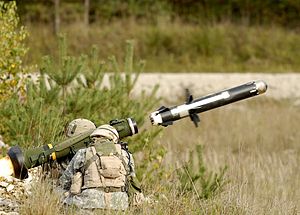Anti-tank guided missile: Difference between revisions
Schierbecker (talk | contribs) linked medium |
Schierbecker (talk | contribs) m moved Anti-tank guided missile to Anti-tank missile over redirect: bold move. Common name. |
(No difference)
| |
Revision as of 06:00, 3 February 2011
This article needs additional citations for verification. (January 2010) |


An anti-tank guided missile (ATGM) or anti-tank guided weapon (ATGW) is a guided missile primarily designed to hit and destroy heavily-armored tanks and other armored fighting vehicles.
ATGMs range in size from shoulder-launched weapons which can be transported by a single soldier, to larger tripod-mounted weapons which require a squad or team to transport and fire, to vehicle and aircraft mounted missile systems.
The introduction of smaller, man-portable ATGMs with larger warheads to the modern battlefield has given infantry the ability to defeat light and medium tanks at great ranges, though main battle tanks using composite and reactive armors have proven to resistant to smaller ATGMs[1][2]. Earlier infantry anti-tank weapons such as anti-tank rifles, anti-tank rockets and magnetic anti-tank mines had limited armor-penetration abilities and/or required a soldier to approach the target closely.
History



First-generation manually command guided MCLOS missiles to become operational and to see combat was the French Nord SS.10 in the early 1950s which require input from an operator using a joystick or similar device to steer the missile to the target. The disadvantage is that the operator must keep the sights cross hairs on the target and then steer the missile into the cross hairs—i.e. the line-of-sight. To do this the operator must be well trained (spending hundreds of hours on a simulator) and must remain stationary and in view of the target during the flight time of the missile. Because of this, the operator is vulnerable while guiding the missile.
Second-generation semi-automatically command guided SACLOS missiles require the operator to only keep the sights on the target until impact. Automatic guidance commands are sent to the missile through wires or radio, or the missile relies on laser marking or a TV camera view from the nose of the missile. Examples are the Russian 9M133 Kornet and the American Hellfire I missiles. Again the operator must remain stationary during the missile's flight.
Third-generation guidance systems rely on a laser, electro-optical imager (IIR) seeker or a W band radar seeker in the nose of the missile. Once the target is identified the missile needs no further guidance during flight; it is "fire-and-forget", and the operator is free to retreat. However, fire-and-forget missiles are more subject to electronic countermeasures than MCLOS and SACLOS missiles. Examples include the Russian Vikhr, German PARS 3 LR, Israeli Spike and the Indian Nag. But due to the ads of the manufactures of various antitank missiles in the past and today there is some confusion and dispute as to whether the newer antitank missiles are 3rd generation or what some are claiming are 4th generation antitank missiles.
Most modern ATGMs have shaped-charge high explosive (HEAT) warheads, designed specifically for penetrating armor. Tandem-charge missiles attempt to defeat ERA protected armor. The small initial charge sets off the ERA while the follow up main charge attempts to penetrate the main armor. Top-attack weapons such as the Indian Nag and the Swedish Bill are designed to focus the explosion down through an armored fighting vehicle's thinner turret-roof or upper-hull armor.
All ATGMs are based on laser, radar, command, predicted flight path, or heat guided systems. Therefore, RPGs and rocket launchers are not considered anti-tank guided missiles.
Countermeasures
Countermeasures against ATGMs include spaced, perforated, and composite armour, explosive reactive armour, jammers like the Russian Shtora, and active protection systems (APS) like the Israeli Trophy and the Russian Arena. Traditionally, before "fire-and-forget" ATGMs were used, the most effective countermeasure was to open fire at the location where the missile was fired from: either the operator would be forced to take cover or he would be killed.[1][2]
